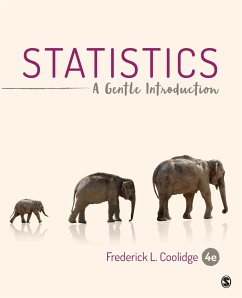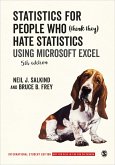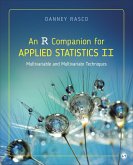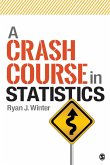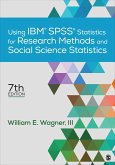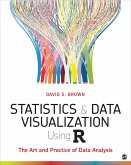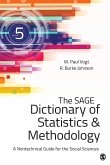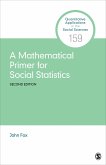- Broschiertes Buch
- Merkliste
- Auf die Merkliste
- Bewerten Bewerten
- Teilen
- Produkt teilen
- Produkterinnerung
- Produkterinnerung
Designed to reduces studentsâ anxieties and minimize unnecessary formulas, this fourth edition provides a comprehensive introduction to basic statistical designs and analyses.
Andere Kunden interessierten sich auch für
![Statistics for People Who (Think They) Hate Statistics - International Student Edition Statistics for People Who (Think They) Hate Statistics - International Student Edition]() Neil J. SalkindStatistics for People Who (Think They) Hate Statistics - International Student Edition138,99 €
Neil J. SalkindStatistics for People Who (Think They) Hate Statistics - International Student Edition138,99 €![An R Companion for Applied Statistics II An R Companion for Applied Statistics II]() Danney Rasco (West Texas A & USA M University)An R Companion for Applied Statistics II77,99 €
Danney Rasco (West Texas A & USA M University)An R Companion for Applied Statistics II77,99 €![A Crash Course in Statistics A Crash Course in Statistics]() Ryan J. WinterA Crash Course in Statistics47,99 €
Ryan J. WinterA Crash Course in Statistics47,99 €![Using IBM® SPSS® Statistics for Research Methods and Social Science Statistics Using IBM® SPSS® Statistics for Research Methods and Social Science Statistics]() William E. Wagner-HuangUsing IBM® SPSS® Statistics for Research Methods and Social Science Statistics77,99 €
William E. Wagner-HuangUsing IBM® SPSS® Statistics for Research Methods and Social Science Statistics77,99 €![Statistics and Data Visualization Using R Statistics and Data Visualization Using R]() David S. S. Brown (University of Colorado, Boulder, USA)Statistics and Data Visualization Using R237,99 €
David S. S. Brown (University of Colorado, Boulder, USA)Statistics and Data Visualization Using R237,99 €![The SAGE Dictionary of Statistics & Methodology The SAGE Dictionary of Statistics & Methodology]() W. Vogt (William) PaulThe SAGE Dictionary of Statistics & Methodology106,99 €
W. Vogt (William) PaulThe SAGE Dictionary of Statistics & Methodology106,99 €![A Mathematical Primer for Social Statistics A Mathematical Primer for Social Statistics]() John Fox (Canada McMaster University)A Mathematical Primer for Social Statistics48,99 €
John Fox (Canada McMaster University)A Mathematical Primer for Social Statistics48,99 €-
-
-
Designed to reduces studentsâ anxieties and minimize unnecessary formulas, this fourth edition provides a comprehensive introduction to basic statistical designs and analyses.
Hinweis: Dieser Artikel kann nur an eine deutsche Lieferadresse ausgeliefert werden.
Hinweis: Dieser Artikel kann nur an eine deutsche Lieferadresse ausgeliefert werden.
Produktdetails
- Produktdetails
- Verlag: SAGE Publications Inc
- 4 Revised edition
- Seitenzahl: 538
- Erscheinungstermin: 27. Januar 2020
- Englisch
- Abmessung: 235mm x 191mm x 29mm
- Gewicht: 954g
- ISBN-13: 9781506368436
- ISBN-10: 1506368433
- Artikelnr.: 58298497
- Herstellerkennzeichnung
- Libri GmbH
- Europaallee 1
- 36244 Bad Hersfeld
- gpsr@libri.de
- Verlag: SAGE Publications Inc
- 4 Revised edition
- Seitenzahl: 538
- Erscheinungstermin: 27. Januar 2020
- Englisch
- Abmessung: 235mm x 191mm x 29mm
- Gewicht: 954g
- ISBN-13: 9781506368436
- ISBN-10: 1506368433
- Artikelnr.: 58298497
- Herstellerkennzeichnung
- Libri GmbH
- Europaallee 1
- 36244 Bad Hersfeld
- gpsr@libri.de
Frederick L. Coolidge (Ph.D.) received his B.A., M.A., and Ph.D. in Psychology at the University of Florida. He completed a two-year postdoctoral fellowship in clinical neuropsychology at Shands Teaching Hospital in Gainesville, Florida. He has been awarded three Fulbright Fellowships to India (1987, 1992, and 2005). He has also won three teaching awards at the University of Colorado (1984, 1987, and 1992), including the lifetime title of University of Colorado Presidential Teaching Scholar. In 2005, he received the University of Colorado at Colorado Springs College of Letters, Arts, and Sciences' Outstanding Research and Creative Works award. Dr. Coolidge conducts research in behavioral genetics and has established the strong heritability of gender identity and gender identity disorder. He also conducts research in lifespan personality assessment and has established the reliability of posthumous personality evaluations, and also applies cognitive models of thinking and language to explain evolutionary changes in the archaeological record.
Preface
Acknowledgments
About the Author
Chapter 1: A Gentle Introduction
How Much Math Do I Need to Do Statistics?
The General Purpose of Statistics: Understanding the World
What Is a Statistician?
Liberal and Conservative Statisticians
Descriptive and Inferential Statistics
Experiments Are Designed to Test Theories and Hypotheses
Oddball Theories
Bad Science and Myths
Eight Essential Questions of Any Survey or Study
On Making Samples Representative of the Population
Experimental Design and Statistical Analysis as Controls
The Language of Statistics
On Conducting Scientific Experiments
The Dependent Variable and Measurement
Operational Definitions
Measurement Error
Measurement Scales: The Difference Between Continuous and Discrete
Variables
Types of Measurement Scales
Rounding Numbers and Rounding Error
Statistical Symbols
Summary
History Trivia: Achenwall to Nightingale
Key Terms
Chapter 1 Practice Problems
Chapter 1 Test Yourself Questions
SPSS Lesson 1
Chapter 2: Descriptive Statistics: Understanding Distributions of Numbers
The Purpose of Graphs and Tables: Making Arguments and Decisions
A Summary of the Purpose of Graphs and Tables
Graphical Cautions
Frequency Distributions
Shapes of Frequency Distributions
Grouping Data Into Intervals
Advice on Grouping Data Into Intervals
The Cumulative Frequency Distribution
Cumulative Percentages, Percentiles, and Quartiles
Stem-and-Leaf Plot
Non-normal Frequency Distributions
On the Importance of the Shapes of Distributions
Additional Thoughts About Good Graphs Versus Bad Graphs
History Trivia: De Moivre to Tukey
Key Terms
Chapter 2 Practice Problems
Chapter 2 Test Yourself Questions
SPSS Lesson 2
Chapter 3: Statistical Parameters: Measures of Central Tendency and
Variation
Measures of Central Tendency
Choosing Among Measures of Central Tendency
Klinkers and Outliers
Uncertain or Equivocal Results
Measures of Variation
Correcting for Bias in the Sample Standard Deviation
How the Square Root of x2 Is Almost Equivalent to Taking the Absolute Value
of x
The Computational Formula for Standard Deviation
The Variance
The Sampling Distribution of Means, the Central Limit Theorem, and the
Standard Error of the Mean
The Use of the Standard Deviation for Prediction
Practical Uses of the Empirical Rule: As a Definition of an Outlier
Practical Uses of the Empirical Rule: Prediction and IQ Tests
Some Further Comments
History Trivia: Fisher to Eels
Key Terms
Chapter 3 Practice Problems
Chapter 3 Test Yourself Questions
SPSS Lesson 3
Chapter 4: Standard Scores, the z Distribution, and Hypothesis Testing
Standard Scores
The Classic Standard Score: The z Score and the z Distribution
Calculating z Scores
More Practice on Converting Raw Data Into z Scores
Converting z Scores to Other Types of Standard Scores
The z Distribution
Interpreting Negative z Scores
Testing the Predictions of the Empirical Rule With the z Distribution
Why Is the z Distribution So Important?
How We Use the z Distribution to Test Experimental Hypotheses
More Practice With the z Distribution and T Scores
Summarizing Scores Through Percentiles
History Trivia: Karl Pearson to Egon Pearson
Key Terms
Chapter 4 Practice Problems
Chapter 4 Test Yourself Questions
SPSS Lesson 4
Chapter 5: Inferential Statistics: The Controlled Experiment, Hypothesis
Testing, and the z Distribution
Hypothesis Testing in the Controlled Experiment
Hypothesis Testing: The Big Decision
How the Big Decision Is Made: Back to the z Distribution
The Parameter of Major Interest in Hypothesis Testing: The Mean
Nondirectional and Directional Alternative Hypotheses
A Debate: Retain the Null Hypothesis or Fail to Reject the Null Hypothesis
The Null Hypothesis as a Nonconservative Beginning
The Four Possible Outcomes in Hypothesis Testing
Significance Levels
Significant and Nonsignificant Findings
Trends, and Does God Really Love the .05 Level of Significance More Than
the .06 Level?
Directional or Nondirectional Alternative Hypotheses: Advantages and
Disadvantages
Did Nuclear Fusion Occur?
Baloney Detection
Conclusions About Science and Pseudoscience
The Most Critical Elements in the Detection of Baloney in Suspicious
Studies and Fraudulent Claims
Can Statistics Solve Every Problem?
Probability
History Trivia: Egon Pearson to Karl Pearson
Key Terms
Chapter 5 Practice Problems
Chapter 5 Test Yourself Questions
SPSS Lesson 5
Chapter 6: An Introduction to Correlation and Regression
Correlation: Use and Abuse
A Warning: Correlation Does Not Imply Causation
Another Warning: Chance Is Lumpy
Correlation and Prediction
The Four Common Types of Correlation
The Pearson Product-Moment Correlation Coefficient
Testing for the Significance of a Correlation Coefficient
Obtaining the Critical Values of the t Distribution
If the Null Hypothesis Is Rejected
Representing the Pearson Correlation Graphically: The Scatterplot
Fitting the Points With a Straight Line: The Assumption of a Linear
Relationship
Interpretation of the Slope of the Best-Fitting Line
The Assumption of Homoscedasticity
The Coefficient of Determination: How Much One Variable Accounts for
Variation in Another Variable-The Interpretation of r2
Quirks in the Interpretation of Significant and Nonsignificant Correlation
Coefficients
Linear Regression
Reading the Regression Line
Final Thoughts About Multiple Regression Analyses: A Warning About the
Interpretation of the Significant Beta Coefficients
Spearman's Correlation
Significance Test for Spearman's r
Ties in Ranks
Point-Biserial Correlation
Testing for the Significance of the Point-Biserial Correlation Coefficient
Phi (F) Correlation
Testing for the Significance of Phi
History Trivia: Galton to Fisher
Key Terms
Chapter 6 Practice Problems
Chapter 6 Test Yourself Questions
SPSS Lesson 6
Chapter 7: The t Test for Independent Groups
The Statistical Analysis of the Controlled Experiment
One t Test but Two Designs
Assumptions of the Independent t Test
The Formula for the Independent t Test
You Must Remember This! An Overview of Hypothesis Testing With the t Test
What Does the t Test Do? Components of the t Test Formula
What If the Two Variances Are Radically Different From One Another?
A Computational Example
Marginal Significance
The Power of a Statistical Test
Effect Size
The Correlation Coefficient of Effect Size
Another Measure of Effect Size: Cohen's d
Confidence Intervals
Estimating the Standard Error
History Trivia: Gosset and Guinness Brewery
Key Terms
Chapter 7 Practice Problems
Chapter 7 Test Yourself Questions
SPSS Lesson 7
Chapter 8: The t Test for Dependent Groups
Variations on the Controlled Experiment
Assumptions of the Dependent t Test
Why the Dependent t Test May Be More Powerful Than the Independent t Test
How to Increase the Power of a t Test
Drawbacks of the Dependent t Test Designs
One-Tailed or Two-Tailed Tests of Significance
Hypothesis Testing and the Dependent t Test: Design 1
Design 1 (Same Participants or Repeated Measures): A Computational Example
Design 2 (Matched Pairs): A Computational Example
Design 3 (Same Participants and Balanced Presentation): A Computational
Example
History Trivia: Fisher to Pearson
Key Terms
Chapter 8 Practice Problems
Chapter 8 Test Yourself Questions
SPSS Lesson 8
Chapter 9: Analysis of Variance (ANOVA): One-Factor Completely Randomized
Design
A Limitation of Multiple t Tests and a Solution
The Equally Unacceptable Bonferroni Solution
The Acceptable Solution: An Analysis of Variance
The Null and Alternative Hypotheses in ANOVA
The Beauty and Elegance of the F Test Statistic
The F Ratio
How Can There Be Two Different Estimates of Within-Groups Variance?
ANOVA Designs
ANOVA Assumptions
Pragmatic Overview
What a Significant ANOVA Indicates
A Computational Example
Degrees of Freedom for the Numerator
Degrees of Freedom for the Denominator
Determining Effect Size in ANOVA: Omega Squared (w2)
Another Measure of Effect Size: Eta (h)
History Trivia: Gosset to Fisher
Key Terms
Chapter 9 Practice Problems
Chapter 9 Test Questions
Chapter 9 Test Yourself Questions
SPSS Lesson 9
Chapter 10: After a Significant ANOVA: Multiple Comparison Tests
Conceptual Overview of Tukey's Test
Computation of Tukey's HSD Test
What to Do If the Number of Error Degrees of Freedom Is Not Listed in the
Table of Tukey's q Values
Determining What It All Means
Warning!
On the Importance of Nonsignificant Mean Differences
Final Results of ANOVA
Quirks in Interpretation
Tukey's With Unequal Ns
Key Terms
Chapter 10 Practice Problems
Chapter 10 Test Yourself Questions
SPSS Lesson 10
Chapter 11: Analysis of Variance (ANOVA): One-Factor Repeated-Measures
Design
The Repeated-Measures ANOVA
Assumptions of the One-Factor Repeated-Measures ANOVA
Computational Example
Determining Effect Size in ANOVA
Key Terms
Chapter 11 Practice Problems
Chapter 11 Test Yourself Questions
SPSS Lesson 11
Chapter 12: Factorial ANOVA: Two-Factor Completely Randomized Design
Factorial Designs
The Most Important Feature of a Factorial Design: The Interaction
Fixed and Random Effects and In Situ Designs
The Null Hypotheses in a Two-Factor ANOVA
Assumptions and Unequal Numbers of Participants
Computational Example
Key Terms
Chapter 12 Practice Problems
Chapter 12 Test Yourself Problems
SPSS Lesson 12
Chapter 13: Post Hoc Analysis of Factorial ANOVA
Main Effect Interpretation: Gender
Why a Multiple Comparison Test Is Unnecessary for a Two-Level Main Effect,
and When Is a Multiple Comparison Test Necessary?
Main Effect: Age Levels
Multiple Comparison Test for the Main Effect for Age
Warning: Limit Your Main Effect Conclusions When the Interaction Is
Significant
Multiple Comparison Tests
Interpretation of the Interaction Effect
Final Summary
Writing Up the Results Journal Style
Language to Avoid
Exploring the Possible Outcomes in a Two-Factor ANOVA
Determining Effect Size in a Two-Factor ANOVA
History Trivia: Fisher and Smoking
Key Terms
Chapter 13 Practice Problems
Chapter 13 Test Yourself Questions
SPSS Lesson 13
Chapter 14: Factorial ANOVA: Additional Designs
The Split-Plot Design
Overview of the Split-Plot ANOVA
Computational Example
Two-Factor ANOVA: Repeated Measures on Both Factors Design
Overview of the Repeated-Measures ANOVA
Computational Example
Key Terms and Definitions
Chapter 14 Practice Problems
Chapter 14 Test Yourself Questions
SPSS Lesson 14
Chapter 15: Nonparametric Statistics: The Chi-Square Test and Other
Nonparametric Tests
Overview of the Purpose of Chi-Square
Overview of Chi-Square Designs
Chi-Square Test: Two-Cell Design (Equal Probabilities Type)
The Chi-Square Distribution
Assumptions of the Chi-Square Test
Chi-Square Test: Two-Cell Design (Different Probabilities Type)
Interpreting a Significant Chi-Square Test for a Newspaper
Chi-Square Test: Three-Cell Experiment (Equal Probabilities Type)
Chi-Square Test: Two-by-Two Design
What to Do After a Chi-Square Test Is Significant
When Cell Frequencies Are Less Than 5 Revisited
Other Nonparametric Tests
History Trivia: Pearson and Biometrika
Key Terms
Chapter 15 Practice Problems
Chapter 15 Test Yourself Questions
SPSS Lesson 15
Chapter 16: Other Statistical Topics, Parameters, and Tests
Big Data
Health Science Statistics
Additional Statistical Analyses and Multivariate Statistics
A Summary of Multivariate Statistics
Coda
Key Terms
Chapter 16 Practice Problems
Chapter 16 Test Yourself Questions
Appendix A: z Distribution
Appendix B: t Distribution
Appendix C: Spearman's Correlation
Appendix D: Chi-Square ?2 Distribution
Appendix E: F Distribution
Appendix F: Tukey's Table
Appendix G: Mann-Whitney U Critical Values
Appendix H: Wilcoxon Signed-Rank Test Critical Values
Appendix I: Answers to Odd-Numbered Test Yourself Questions
Glossary
References
Index
Acknowledgments
About the Author
Chapter 1: A Gentle Introduction
How Much Math Do I Need to Do Statistics?
The General Purpose of Statistics: Understanding the World
What Is a Statistician?
Liberal and Conservative Statisticians
Descriptive and Inferential Statistics
Experiments Are Designed to Test Theories and Hypotheses
Oddball Theories
Bad Science and Myths
Eight Essential Questions of Any Survey or Study
On Making Samples Representative of the Population
Experimental Design and Statistical Analysis as Controls
The Language of Statistics
On Conducting Scientific Experiments
The Dependent Variable and Measurement
Operational Definitions
Measurement Error
Measurement Scales: The Difference Between Continuous and Discrete
Variables
Types of Measurement Scales
Rounding Numbers and Rounding Error
Statistical Symbols
Summary
History Trivia: Achenwall to Nightingale
Key Terms
Chapter 1 Practice Problems
Chapter 1 Test Yourself Questions
SPSS Lesson 1
Chapter 2: Descriptive Statistics: Understanding Distributions of Numbers
The Purpose of Graphs and Tables: Making Arguments and Decisions
A Summary of the Purpose of Graphs and Tables
Graphical Cautions
Frequency Distributions
Shapes of Frequency Distributions
Grouping Data Into Intervals
Advice on Grouping Data Into Intervals
The Cumulative Frequency Distribution
Cumulative Percentages, Percentiles, and Quartiles
Stem-and-Leaf Plot
Non-normal Frequency Distributions
On the Importance of the Shapes of Distributions
Additional Thoughts About Good Graphs Versus Bad Graphs
History Trivia: De Moivre to Tukey
Key Terms
Chapter 2 Practice Problems
Chapter 2 Test Yourself Questions
SPSS Lesson 2
Chapter 3: Statistical Parameters: Measures of Central Tendency and
Variation
Measures of Central Tendency
Choosing Among Measures of Central Tendency
Klinkers and Outliers
Uncertain or Equivocal Results
Measures of Variation
Correcting for Bias in the Sample Standard Deviation
How the Square Root of x2 Is Almost Equivalent to Taking the Absolute Value
of x
The Computational Formula for Standard Deviation
The Variance
The Sampling Distribution of Means, the Central Limit Theorem, and the
Standard Error of the Mean
The Use of the Standard Deviation for Prediction
Practical Uses of the Empirical Rule: As a Definition of an Outlier
Practical Uses of the Empirical Rule: Prediction and IQ Tests
Some Further Comments
History Trivia: Fisher to Eels
Key Terms
Chapter 3 Practice Problems
Chapter 3 Test Yourself Questions
SPSS Lesson 3
Chapter 4: Standard Scores, the z Distribution, and Hypothesis Testing
Standard Scores
The Classic Standard Score: The z Score and the z Distribution
Calculating z Scores
More Practice on Converting Raw Data Into z Scores
Converting z Scores to Other Types of Standard Scores
The z Distribution
Interpreting Negative z Scores
Testing the Predictions of the Empirical Rule With the z Distribution
Why Is the z Distribution So Important?
How We Use the z Distribution to Test Experimental Hypotheses
More Practice With the z Distribution and T Scores
Summarizing Scores Through Percentiles
History Trivia: Karl Pearson to Egon Pearson
Key Terms
Chapter 4 Practice Problems
Chapter 4 Test Yourself Questions
SPSS Lesson 4
Chapter 5: Inferential Statistics: The Controlled Experiment, Hypothesis
Testing, and the z Distribution
Hypothesis Testing in the Controlled Experiment
Hypothesis Testing: The Big Decision
How the Big Decision Is Made: Back to the z Distribution
The Parameter of Major Interest in Hypothesis Testing: The Mean
Nondirectional and Directional Alternative Hypotheses
A Debate: Retain the Null Hypothesis or Fail to Reject the Null Hypothesis
The Null Hypothesis as a Nonconservative Beginning
The Four Possible Outcomes in Hypothesis Testing
Significance Levels
Significant and Nonsignificant Findings
Trends, and Does God Really Love the .05 Level of Significance More Than
the .06 Level?
Directional or Nondirectional Alternative Hypotheses: Advantages and
Disadvantages
Did Nuclear Fusion Occur?
Baloney Detection
Conclusions About Science and Pseudoscience
The Most Critical Elements in the Detection of Baloney in Suspicious
Studies and Fraudulent Claims
Can Statistics Solve Every Problem?
Probability
History Trivia: Egon Pearson to Karl Pearson
Key Terms
Chapter 5 Practice Problems
Chapter 5 Test Yourself Questions
SPSS Lesson 5
Chapter 6: An Introduction to Correlation and Regression
Correlation: Use and Abuse
A Warning: Correlation Does Not Imply Causation
Another Warning: Chance Is Lumpy
Correlation and Prediction
The Four Common Types of Correlation
The Pearson Product-Moment Correlation Coefficient
Testing for the Significance of a Correlation Coefficient
Obtaining the Critical Values of the t Distribution
If the Null Hypothesis Is Rejected
Representing the Pearson Correlation Graphically: The Scatterplot
Fitting the Points With a Straight Line: The Assumption of a Linear
Relationship
Interpretation of the Slope of the Best-Fitting Line
The Assumption of Homoscedasticity
The Coefficient of Determination: How Much One Variable Accounts for
Variation in Another Variable-The Interpretation of r2
Quirks in the Interpretation of Significant and Nonsignificant Correlation
Coefficients
Linear Regression
Reading the Regression Line
Final Thoughts About Multiple Regression Analyses: A Warning About the
Interpretation of the Significant Beta Coefficients
Spearman's Correlation
Significance Test for Spearman's r
Ties in Ranks
Point-Biserial Correlation
Testing for the Significance of the Point-Biserial Correlation Coefficient
Phi (F) Correlation
Testing for the Significance of Phi
History Trivia: Galton to Fisher
Key Terms
Chapter 6 Practice Problems
Chapter 6 Test Yourself Questions
SPSS Lesson 6
Chapter 7: The t Test for Independent Groups
The Statistical Analysis of the Controlled Experiment
One t Test but Two Designs
Assumptions of the Independent t Test
The Formula for the Independent t Test
You Must Remember This! An Overview of Hypothesis Testing With the t Test
What Does the t Test Do? Components of the t Test Formula
What If the Two Variances Are Radically Different From One Another?
A Computational Example
Marginal Significance
The Power of a Statistical Test
Effect Size
The Correlation Coefficient of Effect Size
Another Measure of Effect Size: Cohen's d
Confidence Intervals
Estimating the Standard Error
History Trivia: Gosset and Guinness Brewery
Key Terms
Chapter 7 Practice Problems
Chapter 7 Test Yourself Questions
SPSS Lesson 7
Chapter 8: The t Test for Dependent Groups
Variations on the Controlled Experiment
Assumptions of the Dependent t Test
Why the Dependent t Test May Be More Powerful Than the Independent t Test
How to Increase the Power of a t Test
Drawbacks of the Dependent t Test Designs
One-Tailed or Two-Tailed Tests of Significance
Hypothesis Testing and the Dependent t Test: Design 1
Design 1 (Same Participants or Repeated Measures): A Computational Example
Design 2 (Matched Pairs): A Computational Example
Design 3 (Same Participants and Balanced Presentation): A Computational
Example
History Trivia: Fisher to Pearson
Key Terms
Chapter 8 Practice Problems
Chapter 8 Test Yourself Questions
SPSS Lesson 8
Chapter 9: Analysis of Variance (ANOVA): One-Factor Completely Randomized
Design
A Limitation of Multiple t Tests and a Solution
The Equally Unacceptable Bonferroni Solution
The Acceptable Solution: An Analysis of Variance
The Null and Alternative Hypotheses in ANOVA
The Beauty and Elegance of the F Test Statistic
The F Ratio
How Can There Be Two Different Estimates of Within-Groups Variance?
ANOVA Designs
ANOVA Assumptions
Pragmatic Overview
What a Significant ANOVA Indicates
A Computational Example
Degrees of Freedom for the Numerator
Degrees of Freedom for the Denominator
Determining Effect Size in ANOVA: Omega Squared (w2)
Another Measure of Effect Size: Eta (h)
History Trivia: Gosset to Fisher
Key Terms
Chapter 9 Practice Problems
Chapter 9 Test Questions
Chapter 9 Test Yourself Questions
SPSS Lesson 9
Chapter 10: After a Significant ANOVA: Multiple Comparison Tests
Conceptual Overview of Tukey's Test
Computation of Tukey's HSD Test
What to Do If the Number of Error Degrees of Freedom Is Not Listed in the
Table of Tukey's q Values
Determining What It All Means
Warning!
On the Importance of Nonsignificant Mean Differences
Final Results of ANOVA
Quirks in Interpretation
Tukey's With Unequal Ns
Key Terms
Chapter 10 Practice Problems
Chapter 10 Test Yourself Questions
SPSS Lesson 10
Chapter 11: Analysis of Variance (ANOVA): One-Factor Repeated-Measures
Design
The Repeated-Measures ANOVA
Assumptions of the One-Factor Repeated-Measures ANOVA
Computational Example
Determining Effect Size in ANOVA
Key Terms
Chapter 11 Practice Problems
Chapter 11 Test Yourself Questions
SPSS Lesson 11
Chapter 12: Factorial ANOVA: Two-Factor Completely Randomized Design
Factorial Designs
The Most Important Feature of a Factorial Design: The Interaction
Fixed and Random Effects and In Situ Designs
The Null Hypotheses in a Two-Factor ANOVA
Assumptions and Unequal Numbers of Participants
Computational Example
Key Terms
Chapter 12 Practice Problems
Chapter 12 Test Yourself Problems
SPSS Lesson 12
Chapter 13: Post Hoc Analysis of Factorial ANOVA
Main Effect Interpretation: Gender
Why a Multiple Comparison Test Is Unnecessary for a Two-Level Main Effect,
and When Is a Multiple Comparison Test Necessary?
Main Effect: Age Levels
Multiple Comparison Test for the Main Effect for Age
Warning: Limit Your Main Effect Conclusions When the Interaction Is
Significant
Multiple Comparison Tests
Interpretation of the Interaction Effect
Final Summary
Writing Up the Results Journal Style
Language to Avoid
Exploring the Possible Outcomes in a Two-Factor ANOVA
Determining Effect Size in a Two-Factor ANOVA
History Trivia: Fisher and Smoking
Key Terms
Chapter 13 Practice Problems
Chapter 13 Test Yourself Questions
SPSS Lesson 13
Chapter 14: Factorial ANOVA: Additional Designs
The Split-Plot Design
Overview of the Split-Plot ANOVA
Computational Example
Two-Factor ANOVA: Repeated Measures on Both Factors Design
Overview of the Repeated-Measures ANOVA
Computational Example
Key Terms and Definitions
Chapter 14 Practice Problems
Chapter 14 Test Yourself Questions
SPSS Lesson 14
Chapter 15: Nonparametric Statistics: The Chi-Square Test and Other
Nonparametric Tests
Overview of the Purpose of Chi-Square
Overview of Chi-Square Designs
Chi-Square Test: Two-Cell Design (Equal Probabilities Type)
The Chi-Square Distribution
Assumptions of the Chi-Square Test
Chi-Square Test: Two-Cell Design (Different Probabilities Type)
Interpreting a Significant Chi-Square Test for a Newspaper
Chi-Square Test: Three-Cell Experiment (Equal Probabilities Type)
Chi-Square Test: Two-by-Two Design
What to Do After a Chi-Square Test Is Significant
When Cell Frequencies Are Less Than 5 Revisited
Other Nonparametric Tests
History Trivia: Pearson and Biometrika
Key Terms
Chapter 15 Practice Problems
Chapter 15 Test Yourself Questions
SPSS Lesson 15
Chapter 16: Other Statistical Topics, Parameters, and Tests
Big Data
Health Science Statistics
Additional Statistical Analyses and Multivariate Statistics
A Summary of Multivariate Statistics
Coda
Key Terms
Chapter 16 Practice Problems
Chapter 16 Test Yourself Questions
Appendix A: z Distribution
Appendix B: t Distribution
Appendix C: Spearman's Correlation
Appendix D: Chi-Square ?2 Distribution
Appendix E: F Distribution
Appendix F: Tukey's Table
Appendix G: Mann-Whitney U Critical Values
Appendix H: Wilcoxon Signed-Rank Test Critical Values
Appendix I: Answers to Odd-Numbered Test Yourself Questions
Glossary
References
Index
Preface
Acknowledgments
About the Author
Chapter 1: A Gentle Introduction
How Much Math Do I Need to Do Statistics?
The General Purpose of Statistics: Understanding the World
What Is a Statistician?
Liberal and Conservative Statisticians
Descriptive and Inferential Statistics
Experiments Are Designed to Test Theories and Hypotheses
Oddball Theories
Bad Science and Myths
Eight Essential Questions of Any Survey or Study
On Making Samples Representative of the Population
Experimental Design and Statistical Analysis as Controls
The Language of Statistics
On Conducting Scientific Experiments
The Dependent Variable and Measurement
Operational Definitions
Measurement Error
Measurement Scales: The Difference Between Continuous and Discrete
Variables
Types of Measurement Scales
Rounding Numbers and Rounding Error
Statistical Symbols
Summary
History Trivia: Achenwall to Nightingale
Key Terms
Chapter 1 Practice Problems
Chapter 1 Test Yourself Questions
SPSS Lesson 1
Chapter 2: Descriptive Statistics: Understanding Distributions of Numbers
The Purpose of Graphs and Tables: Making Arguments and Decisions
A Summary of the Purpose of Graphs and Tables
Graphical Cautions
Frequency Distributions
Shapes of Frequency Distributions
Grouping Data Into Intervals
Advice on Grouping Data Into Intervals
The Cumulative Frequency Distribution
Cumulative Percentages, Percentiles, and Quartiles
Stem-and-Leaf Plot
Non-normal Frequency Distributions
On the Importance of the Shapes of Distributions
Additional Thoughts About Good Graphs Versus Bad Graphs
History Trivia: De Moivre to Tukey
Key Terms
Chapter 2 Practice Problems
Chapter 2 Test Yourself Questions
SPSS Lesson 2
Chapter 3: Statistical Parameters: Measures of Central Tendency and
Variation
Measures of Central Tendency
Choosing Among Measures of Central Tendency
Klinkers and Outliers
Uncertain or Equivocal Results
Measures of Variation
Correcting for Bias in the Sample Standard Deviation
How the Square Root of x2 Is Almost Equivalent to Taking the Absolute Value
of x
The Computational Formula for Standard Deviation
The Variance
The Sampling Distribution of Means, the Central Limit Theorem, and the
Standard Error of the Mean
The Use of the Standard Deviation for Prediction
Practical Uses of the Empirical Rule: As a Definition of an Outlier
Practical Uses of the Empirical Rule: Prediction and IQ Tests
Some Further Comments
History Trivia: Fisher to Eels
Key Terms
Chapter 3 Practice Problems
Chapter 3 Test Yourself Questions
SPSS Lesson 3
Chapter 4: Standard Scores, the z Distribution, and Hypothesis Testing
Standard Scores
The Classic Standard Score: The z Score and the z Distribution
Calculating z Scores
More Practice on Converting Raw Data Into z Scores
Converting z Scores to Other Types of Standard Scores
The z Distribution
Interpreting Negative z Scores
Testing the Predictions of the Empirical Rule With the z Distribution
Why Is the z Distribution So Important?
How We Use the z Distribution to Test Experimental Hypotheses
More Practice With the z Distribution and T Scores
Summarizing Scores Through Percentiles
History Trivia: Karl Pearson to Egon Pearson
Key Terms
Chapter 4 Practice Problems
Chapter 4 Test Yourself Questions
SPSS Lesson 4
Chapter 5: Inferential Statistics: The Controlled Experiment, Hypothesis
Testing, and the z Distribution
Hypothesis Testing in the Controlled Experiment
Hypothesis Testing: The Big Decision
How the Big Decision Is Made: Back to the z Distribution
The Parameter of Major Interest in Hypothesis Testing: The Mean
Nondirectional and Directional Alternative Hypotheses
A Debate: Retain the Null Hypothesis or Fail to Reject the Null Hypothesis
The Null Hypothesis as a Nonconservative Beginning
The Four Possible Outcomes in Hypothesis Testing
Significance Levels
Significant and Nonsignificant Findings
Trends, and Does God Really Love the .05 Level of Significance More Than
the .06 Level?
Directional or Nondirectional Alternative Hypotheses: Advantages and
Disadvantages
Did Nuclear Fusion Occur?
Baloney Detection
Conclusions About Science and Pseudoscience
The Most Critical Elements in the Detection of Baloney in Suspicious
Studies and Fraudulent Claims
Can Statistics Solve Every Problem?
Probability
History Trivia: Egon Pearson to Karl Pearson
Key Terms
Chapter 5 Practice Problems
Chapter 5 Test Yourself Questions
SPSS Lesson 5
Chapter 6: An Introduction to Correlation and Regression
Correlation: Use and Abuse
A Warning: Correlation Does Not Imply Causation
Another Warning: Chance Is Lumpy
Correlation and Prediction
The Four Common Types of Correlation
The Pearson Product-Moment Correlation Coefficient
Testing for the Significance of a Correlation Coefficient
Obtaining the Critical Values of the t Distribution
If the Null Hypothesis Is Rejected
Representing the Pearson Correlation Graphically: The Scatterplot
Fitting the Points With a Straight Line: The Assumption of a Linear
Relationship
Interpretation of the Slope of the Best-Fitting Line
The Assumption of Homoscedasticity
The Coefficient of Determination: How Much One Variable Accounts for
Variation in Another Variable-The Interpretation of r2
Quirks in the Interpretation of Significant and Nonsignificant Correlation
Coefficients
Linear Regression
Reading the Regression Line
Final Thoughts About Multiple Regression Analyses: A Warning About the
Interpretation of the Significant Beta Coefficients
Spearman's Correlation
Significance Test for Spearman's r
Ties in Ranks
Point-Biserial Correlation
Testing for the Significance of the Point-Biserial Correlation Coefficient
Phi (F) Correlation
Testing for the Significance of Phi
History Trivia: Galton to Fisher
Key Terms
Chapter 6 Practice Problems
Chapter 6 Test Yourself Questions
SPSS Lesson 6
Chapter 7: The t Test for Independent Groups
The Statistical Analysis of the Controlled Experiment
One t Test but Two Designs
Assumptions of the Independent t Test
The Formula for the Independent t Test
You Must Remember This! An Overview of Hypothesis Testing With the t Test
What Does the t Test Do? Components of the t Test Formula
What If the Two Variances Are Radically Different From One Another?
A Computational Example
Marginal Significance
The Power of a Statistical Test
Effect Size
The Correlation Coefficient of Effect Size
Another Measure of Effect Size: Cohen's d
Confidence Intervals
Estimating the Standard Error
History Trivia: Gosset and Guinness Brewery
Key Terms
Chapter 7 Practice Problems
Chapter 7 Test Yourself Questions
SPSS Lesson 7
Chapter 8: The t Test for Dependent Groups
Variations on the Controlled Experiment
Assumptions of the Dependent t Test
Why the Dependent t Test May Be More Powerful Than the Independent t Test
How to Increase the Power of a t Test
Drawbacks of the Dependent t Test Designs
One-Tailed or Two-Tailed Tests of Significance
Hypothesis Testing and the Dependent t Test: Design 1
Design 1 (Same Participants or Repeated Measures): A Computational Example
Design 2 (Matched Pairs): A Computational Example
Design 3 (Same Participants and Balanced Presentation): A Computational
Example
History Trivia: Fisher to Pearson
Key Terms
Chapter 8 Practice Problems
Chapter 8 Test Yourself Questions
SPSS Lesson 8
Chapter 9: Analysis of Variance (ANOVA): One-Factor Completely Randomized
Design
A Limitation of Multiple t Tests and a Solution
The Equally Unacceptable Bonferroni Solution
The Acceptable Solution: An Analysis of Variance
The Null and Alternative Hypotheses in ANOVA
The Beauty and Elegance of the F Test Statistic
The F Ratio
How Can There Be Two Different Estimates of Within-Groups Variance?
ANOVA Designs
ANOVA Assumptions
Pragmatic Overview
What a Significant ANOVA Indicates
A Computational Example
Degrees of Freedom for the Numerator
Degrees of Freedom for the Denominator
Determining Effect Size in ANOVA: Omega Squared (w2)
Another Measure of Effect Size: Eta (h)
History Trivia: Gosset to Fisher
Key Terms
Chapter 9 Practice Problems
Chapter 9 Test Questions
Chapter 9 Test Yourself Questions
SPSS Lesson 9
Chapter 10: After a Significant ANOVA: Multiple Comparison Tests
Conceptual Overview of Tukey's Test
Computation of Tukey's HSD Test
What to Do If the Number of Error Degrees of Freedom Is Not Listed in the
Table of Tukey's q Values
Determining What It All Means
Warning!
On the Importance of Nonsignificant Mean Differences
Final Results of ANOVA
Quirks in Interpretation
Tukey's With Unequal Ns
Key Terms
Chapter 10 Practice Problems
Chapter 10 Test Yourself Questions
SPSS Lesson 10
Chapter 11: Analysis of Variance (ANOVA): One-Factor Repeated-Measures
Design
The Repeated-Measures ANOVA
Assumptions of the One-Factor Repeated-Measures ANOVA
Computational Example
Determining Effect Size in ANOVA
Key Terms
Chapter 11 Practice Problems
Chapter 11 Test Yourself Questions
SPSS Lesson 11
Chapter 12: Factorial ANOVA: Two-Factor Completely Randomized Design
Factorial Designs
The Most Important Feature of a Factorial Design: The Interaction
Fixed and Random Effects and In Situ Designs
The Null Hypotheses in a Two-Factor ANOVA
Assumptions and Unequal Numbers of Participants
Computational Example
Key Terms
Chapter 12 Practice Problems
Chapter 12 Test Yourself Problems
SPSS Lesson 12
Chapter 13: Post Hoc Analysis of Factorial ANOVA
Main Effect Interpretation: Gender
Why a Multiple Comparison Test Is Unnecessary for a Two-Level Main Effect,
and When Is a Multiple Comparison Test Necessary?
Main Effect: Age Levels
Multiple Comparison Test for the Main Effect for Age
Warning: Limit Your Main Effect Conclusions When the Interaction Is
Significant
Multiple Comparison Tests
Interpretation of the Interaction Effect
Final Summary
Writing Up the Results Journal Style
Language to Avoid
Exploring the Possible Outcomes in a Two-Factor ANOVA
Determining Effect Size in a Two-Factor ANOVA
History Trivia: Fisher and Smoking
Key Terms
Chapter 13 Practice Problems
Chapter 13 Test Yourself Questions
SPSS Lesson 13
Chapter 14: Factorial ANOVA: Additional Designs
The Split-Plot Design
Overview of the Split-Plot ANOVA
Computational Example
Two-Factor ANOVA: Repeated Measures on Both Factors Design
Overview of the Repeated-Measures ANOVA
Computational Example
Key Terms and Definitions
Chapter 14 Practice Problems
Chapter 14 Test Yourself Questions
SPSS Lesson 14
Chapter 15: Nonparametric Statistics: The Chi-Square Test and Other
Nonparametric Tests
Overview of the Purpose of Chi-Square
Overview of Chi-Square Designs
Chi-Square Test: Two-Cell Design (Equal Probabilities Type)
The Chi-Square Distribution
Assumptions of the Chi-Square Test
Chi-Square Test: Two-Cell Design (Different Probabilities Type)
Interpreting a Significant Chi-Square Test for a Newspaper
Chi-Square Test: Three-Cell Experiment (Equal Probabilities Type)
Chi-Square Test: Two-by-Two Design
What to Do After a Chi-Square Test Is Significant
When Cell Frequencies Are Less Than 5 Revisited
Other Nonparametric Tests
History Trivia: Pearson and Biometrika
Key Terms
Chapter 15 Practice Problems
Chapter 15 Test Yourself Questions
SPSS Lesson 15
Chapter 16: Other Statistical Topics, Parameters, and Tests
Big Data
Health Science Statistics
Additional Statistical Analyses and Multivariate Statistics
A Summary of Multivariate Statistics
Coda
Key Terms
Chapter 16 Practice Problems
Chapter 16 Test Yourself Questions
Appendix A: z Distribution
Appendix B: t Distribution
Appendix C: Spearman's Correlation
Appendix D: Chi-Square ?2 Distribution
Appendix E: F Distribution
Appendix F: Tukey's Table
Appendix G: Mann-Whitney U Critical Values
Appendix H: Wilcoxon Signed-Rank Test Critical Values
Appendix I: Answers to Odd-Numbered Test Yourself Questions
Glossary
References
Index
Acknowledgments
About the Author
Chapter 1: A Gentle Introduction
How Much Math Do I Need to Do Statistics?
The General Purpose of Statistics: Understanding the World
What Is a Statistician?
Liberal and Conservative Statisticians
Descriptive and Inferential Statistics
Experiments Are Designed to Test Theories and Hypotheses
Oddball Theories
Bad Science and Myths
Eight Essential Questions of Any Survey or Study
On Making Samples Representative of the Population
Experimental Design and Statistical Analysis as Controls
The Language of Statistics
On Conducting Scientific Experiments
The Dependent Variable and Measurement
Operational Definitions
Measurement Error
Measurement Scales: The Difference Between Continuous and Discrete
Variables
Types of Measurement Scales
Rounding Numbers and Rounding Error
Statistical Symbols
Summary
History Trivia: Achenwall to Nightingale
Key Terms
Chapter 1 Practice Problems
Chapter 1 Test Yourself Questions
SPSS Lesson 1
Chapter 2: Descriptive Statistics: Understanding Distributions of Numbers
The Purpose of Graphs and Tables: Making Arguments and Decisions
A Summary of the Purpose of Graphs and Tables
Graphical Cautions
Frequency Distributions
Shapes of Frequency Distributions
Grouping Data Into Intervals
Advice on Grouping Data Into Intervals
The Cumulative Frequency Distribution
Cumulative Percentages, Percentiles, and Quartiles
Stem-and-Leaf Plot
Non-normal Frequency Distributions
On the Importance of the Shapes of Distributions
Additional Thoughts About Good Graphs Versus Bad Graphs
History Trivia: De Moivre to Tukey
Key Terms
Chapter 2 Practice Problems
Chapter 2 Test Yourself Questions
SPSS Lesson 2
Chapter 3: Statistical Parameters: Measures of Central Tendency and
Variation
Measures of Central Tendency
Choosing Among Measures of Central Tendency
Klinkers and Outliers
Uncertain or Equivocal Results
Measures of Variation
Correcting for Bias in the Sample Standard Deviation
How the Square Root of x2 Is Almost Equivalent to Taking the Absolute Value
of x
The Computational Formula for Standard Deviation
The Variance
The Sampling Distribution of Means, the Central Limit Theorem, and the
Standard Error of the Mean
The Use of the Standard Deviation for Prediction
Practical Uses of the Empirical Rule: As a Definition of an Outlier
Practical Uses of the Empirical Rule: Prediction and IQ Tests
Some Further Comments
History Trivia: Fisher to Eels
Key Terms
Chapter 3 Practice Problems
Chapter 3 Test Yourself Questions
SPSS Lesson 3
Chapter 4: Standard Scores, the z Distribution, and Hypothesis Testing
Standard Scores
The Classic Standard Score: The z Score and the z Distribution
Calculating z Scores
More Practice on Converting Raw Data Into z Scores
Converting z Scores to Other Types of Standard Scores
The z Distribution
Interpreting Negative z Scores
Testing the Predictions of the Empirical Rule With the z Distribution
Why Is the z Distribution So Important?
How We Use the z Distribution to Test Experimental Hypotheses
More Practice With the z Distribution and T Scores
Summarizing Scores Through Percentiles
History Trivia: Karl Pearson to Egon Pearson
Key Terms
Chapter 4 Practice Problems
Chapter 4 Test Yourself Questions
SPSS Lesson 4
Chapter 5: Inferential Statistics: The Controlled Experiment, Hypothesis
Testing, and the z Distribution
Hypothesis Testing in the Controlled Experiment
Hypothesis Testing: The Big Decision
How the Big Decision Is Made: Back to the z Distribution
The Parameter of Major Interest in Hypothesis Testing: The Mean
Nondirectional and Directional Alternative Hypotheses
A Debate: Retain the Null Hypothesis or Fail to Reject the Null Hypothesis
The Null Hypothesis as a Nonconservative Beginning
The Four Possible Outcomes in Hypothesis Testing
Significance Levels
Significant and Nonsignificant Findings
Trends, and Does God Really Love the .05 Level of Significance More Than
the .06 Level?
Directional or Nondirectional Alternative Hypotheses: Advantages and
Disadvantages
Did Nuclear Fusion Occur?
Baloney Detection
Conclusions About Science and Pseudoscience
The Most Critical Elements in the Detection of Baloney in Suspicious
Studies and Fraudulent Claims
Can Statistics Solve Every Problem?
Probability
History Trivia: Egon Pearson to Karl Pearson
Key Terms
Chapter 5 Practice Problems
Chapter 5 Test Yourself Questions
SPSS Lesson 5
Chapter 6: An Introduction to Correlation and Regression
Correlation: Use and Abuse
A Warning: Correlation Does Not Imply Causation
Another Warning: Chance Is Lumpy
Correlation and Prediction
The Four Common Types of Correlation
The Pearson Product-Moment Correlation Coefficient
Testing for the Significance of a Correlation Coefficient
Obtaining the Critical Values of the t Distribution
If the Null Hypothesis Is Rejected
Representing the Pearson Correlation Graphically: The Scatterplot
Fitting the Points With a Straight Line: The Assumption of a Linear
Relationship
Interpretation of the Slope of the Best-Fitting Line
The Assumption of Homoscedasticity
The Coefficient of Determination: How Much One Variable Accounts for
Variation in Another Variable-The Interpretation of r2
Quirks in the Interpretation of Significant and Nonsignificant Correlation
Coefficients
Linear Regression
Reading the Regression Line
Final Thoughts About Multiple Regression Analyses: A Warning About the
Interpretation of the Significant Beta Coefficients
Spearman's Correlation
Significance Test for Spearman's r
Ties in Ranks
Point-Biserial Correlation
Testing for the Significance of the Point-Biserial Correlation Coefficient
Phi (F) Correlation
Testing for the Significance of Phi
History Trivia: Galton to Fisher
Key Terms
Chapter 6 Practice Problems
Chapter 6 Test Yourself Questions
SPSS Lesson 6
Chapter 7: The t Test for Independent Groups
The Statistical Analysis of the Controlled Experiment
One t Test but Two Designs
Assumptions of the Independent t Test
The Formula for the Independent t Test
You Must Remember This! An Overview of Hypothesis Testing With the t Test
What Does the t Test Do? Components of the t Test Formula
What If the Two Variances Are Radically Different From One Another?
A Computational Example
Marginal Significance
The Power of a Statistical Test
Effect Size
The Correlation Coefficient of Effect Size
Another Measure of Effect Size: Cohen's d
Confidence Intervals
Estimating the Standard Error
History Trivia: Gosset and Guinness Brewery
Key Terms
Chapter 7 Practice Problems
Chapter 7 Test Yourself Questions
SPSS Lesson 7
Chapter 8: The t Test for Dependent Groups
Variations on the Controlled Experiment
Assumptions of the Dependent t Test
Why the Dependent t Test May Be More Powerful Than the Independent t Test
How to Increase the Power of a t Test
Drawbacks of the Dependent t Test Designs
One-Tailed or Two-Tailed Tests of Significance
Hypothesis Testing and the Dependent t Test: Design 1
Design 1 (Same Participants or Repeated Measures): A Computational Example
Design 2 (Matched Pairs): A Computational Example
Design 3 (Same Participants and Balanced Presentation): A Computational
Example
History Trivia: Fisher to Pearson
Key Terms
Chapter 8 Practice Problems
Chapter 8 Test Yourself Questions
SPSS Lesson 8
Chapter 9: Analysis of Variance (ANOVA): One-Factor Completely Randomized
Design
A Limitation of Multiple t Tests and a Solution
The Equally Unacceptable Bonferroni Solution
The Acceptable Solution: An Analysis of Variance
The Null and Alternative Hypotheses in ANOVA
The Beauty and Elegance of the F Test Statistic
The F Ratio
How Can There Be Two Different Estimates of Within-Groups Variance?
ANOVA Designs
ANOVA Assumptions
Pragmatic Overview
What a Significant ANOVA Indicates
A Computational Example
Degrees of Freedom for the Numerator
Degrees of Freedom for the Denominator
Determining Effect Size in ANOVA: Omega Squared (w2)
Another Measure of Effect Size: Eta (h)
History Trivia: Gosset to Fisher
Key Terms
Chapter 9 Practice Problems
Chapter 9 Test Questions
Chapter 9 Test Yourself Questions
SPSS Lesson 9
Chapter 10: After a Significant ANOVA: Multiple Comparison Tests
Conceptual Overview of Tukey's Test
Computation of Tukey's HSD Test
What to Do If the Number of Error Degrees of Freedom Is Not Listed in the
Table of Tukey's q Values
Determining What It All Means
Warning!
On the Importance of Nonsignificant Mean Differences
Final Results of ANOVA
Quirks in Interpretation
Tukey's With Unequal Ns
Key Terms
Chapter 10 Practice Problems
Chapter 10 Test Yourself Questions
SPSS Lesson 10
Chapter 11: Analysis of Variance (ANOVA): One-Factor Repeated-Measures
Design
The Repeated-Measures ANOVA
Assumptions of the One-Factor Repeated-Measures ANOVA
Computational Example
Determining Effect Size in ANOVA
Key Terms
Chapter 11 Practice Problems
Chapter 11 Test Yourself Questions
SPSS Lesson 11
Chapter 12: Factorial ANOVA: Two-Factor Completely Randomized Design
Factorial Designs
The Most Important Feature of a Factorial Design: The Interaction
Fixed and Random Effects and In Situ Designs
The Null Hypotheses in a Two-Factor ANOVA
Assumptions and Unequal Numbers of Participants
Computational Example
Key Terms
Chapter 12 Practice Problems
Chapter 12 Test Yourself Problems
SPSS Lesson 12
Chapter 13: Post Hoc Analysis of Factorial ANOVA
Main Effect Interpretation: Gender
Why a Multiple Comparison Test Is Unnecessary for a Two-Level Main Effect,
and When Is a Multiple Comparison Test Necessary?
Main Effect: Age Levels
Multiple Comparison Test for the Main Effect for Age
Warning: Limit Your Main Effect Conclusions When the Interaction Is
Significant
Multiple Comparison Tests
Interpretation of the Interaction Effect
Final Summary
Writing Up the Results Journal Style
Language to Avoid
Exploring the Possible Outcomes in a Two-Factor ANOVA
Determining Effect Size in a Two-Factor ANOVA
History Trivia: Fisher and Smoking
Key Terms
Chapter 13 Practice Problems
Chapter 13 Test Yourself Questions
SPSS Lesson 13
Chapter 14: Factorial ANOVA: Additional Designs
The Split-Plot Design
Overview of the Split-Plot ANOVA
Computational Example
Two-Factor ANOVA: Repeated Measures on Both Factors Design
Overview of the Repeated-Measures ANOVA
Computational Example
Key Terms and Definitions
Chapter 14 Practice Problems
Chapter 14 Test Yourself Questions
SPSS Lesson 14
Chapter 15: Nonparametric Statistics: The Chi-Square Test and Other
Nonparametric Tests
Overview of the Purpose of Chi-Square
Overview of Chi-Square Designs
Chi-Square Test: Two-Cell Design (Equal Probabilities Type)
The Chi-Square Distribution
Assumptions of the Chi-Square Test
Chi-Square Test: Two-Cell Design (Different Probabilities Type)
Interpreting a Significant Chi-Square Test for a Newspaper
Chi-Square Test: Three-Cell Experiment (Equal Probabilities Type)
Chi-Square Test: Two-by-Two Design
What to Do After a Chi-Square Test Is Significant
When Cell Frequencies Are Less Than 5 Revisited
Other Nonparametric Tests
History Trivia: Pearson and Biometrika
Key Terms
Chapter 15 Practice Problems
Chapter 15 Test Yourself Questions
SPSS Lesson 15
Chapter 16: Other Statistical Topics, Parameters, and Tests
Big Data
Health Science Statistics
Additional Statistical Analyses and Multivariate Statistics
A Summary of Multivariate Statistics
Coda
Key Terms
Chapter 16 Practice Problems
Chapter 16 Test Yourself Questions
Appendix A: z Distribution
Appendix B: t Distribution
Appendix C: Spearman's Correlation
Appendix D: Chi-Square ?2 Distribution
Appendix E: F Distribution
Appendix F: Tukey's Table
Appendix G: Mann-Whitney U Critical Values
Appendix H: Wilcoxon Signed-Rank Test Critical Values
Appendix I: Answers to Odd-Numbered Test Yourself Questions
Glossary
References
Index

